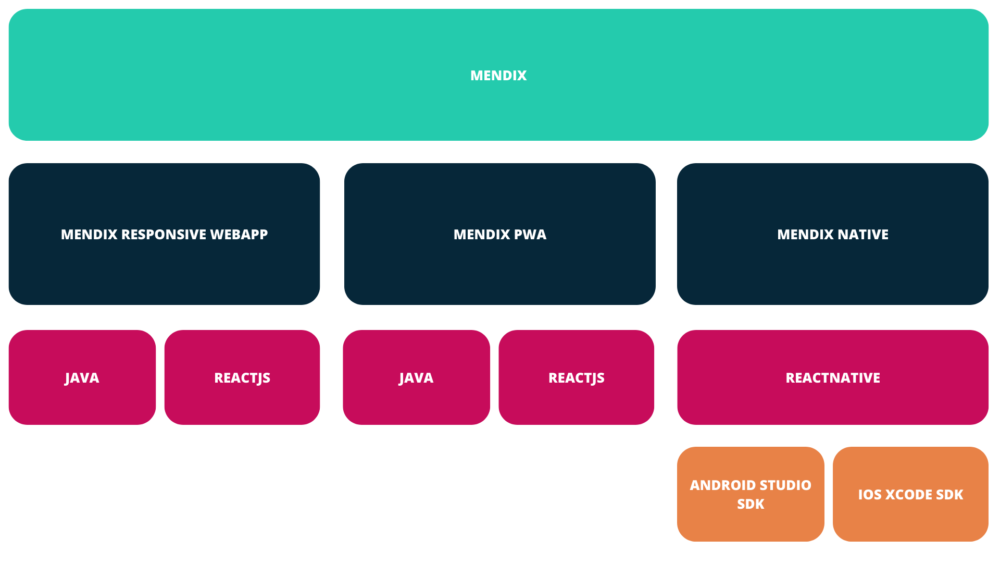Floating on a cloud - Deploying Mendix low-code apps on Microsoft Azure
In this blog we explore the what, how and why of deploying Mendix applications on Microsoft Azure cloud services.
07/12/2022
At some point along their low-code journey, many of our clients decide it’s time to build a mobile app. And the first question they have is - how do we build it? Which often becomes PWA or native? Which one should we use and why? Here’s our take on the subject.

A little context to begin with, for those that haven’t yet faced this conundrum. PWA (progressive web app) and native (for iOS and Android) are two different methods for building mobile apps, each with their own pros and cons.
And within the world of low-code, you have Mendix PWA and Mendix Native - abstraction layers that allow developers to easily work with either PWA or build actual native apps seamlessly. But we’ll get to that a little later. First, let’s look at Native and PWA without any low-code context:
PWA utilises a web-based code system that web developers can relate to. In short, it’s the easier option and much more accessible to most developers as it is built on a web-based coding language (HTML, CSS and Javascript). Since PWA apps are basically websites formatted to hide the URL and other typical web browser features, you don’t need to download anything and it can be distributed easily without the need for public app stores such as Google Play and the Apple store. However, PWA apps offer less features, functionality and usability.
Native on the other hand uses the coding language of mobile operating systems like iOS (Swift language and xCode IDE) and android (JAVA language and Studio IDE). As a result, it typically requires web developers to learn some new skills in order to build and deploy native iOS or Android apps. On the upside, native applications typically offer better performance, speed, user experience, and interaction as it can make use of mobile device features (such as memory, device sensors, cameras and so on).
In the past PWA has been a good choice if you / your team’s skill set is more focused on web development, and if the application you want to build doesn’t require highly advanced features, advanced offline functionality or much notification capabilities. Also, PWA doesn’t run on iOS devices as Apple doesn’t allow PWA to be distributed via the apple store!

Well, thanks to Mendix Native, you can now get all the benefits of a true native built app without the hassle of learning a totally new skill set. Mendix has lowered the barrier to entry for native development by unlocking React Native in the Mendix abstraction, making Native (in our humble opinion) the clear winner in most cases. Here’s why:
Large extensibility possibilities from existing React Native components
The app installs locally and all necessary data and screens are stored on your device, improving performance and allowing you to use it off-line
By adding an extra navigation profile, you activate a 2nd type of app in the same project, in this case a Mendix Native app
Many existing screen components and native functionalities are already available, allowing you to create a visually sleek application right out the box
The separation (in business logic) between responsive and native ensures a more optimal balance in overlapping development work and maintenance
Whether you decide to go with Mendix PWA or Mendix Native, it’s worth pointing out that it’s all possible thanks to Mendix and its abstraction layers. Mendix Native is a great tool as it allows low-code developers to always find the right solution for a given obstacle or use case. Mendix really comes into its own as a development approach when it’s applied to multi-experience applications. For example, perhaps you need an app that will be used by both office staff on their computers and field technicians on their mobile (and potentially off-line) devices. With Mendix you can tackle all of this simultaneously in a single application, without needing multiple developer skill sets.
So, in conclusion, Mendix Native offers a number of great benefits, making it the ideal solution for developing native mobile apps. However, PWA also certainly has its own valuable use cases. It all depends on your specific needs and goals. What’s your opinion? Don’t hesitate and send us an email. We'd love to hear from you!
In this blog we explore the what, how and why of deploying Mendix applications on Microsoft Azure cloud services.
Here’s another slightly technical-focused story for you. This one is all about component-based architecture - what it is, how it works, and what’s so great about it. But perhaps it can also serve as inspiration for development leads and managers!
Mendix is constantly evolving and never stands still! Mendix 9 was introduced in March, and a lot has changed since then. Both the product and the company continue to focus on collaboration and community, which (luckily enough) is directly related to new technical possibilities! So, we've listed 10 of our favorite new technical possibilities.